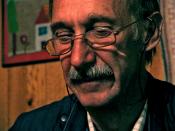Life is Beautiful, the Grand Prix winner at the 1998 Cannes Film Festival, is much like two films in one. In tone, temperament, and intent, they are vastly different -- one is poignant and powerful, the other is light, airy, and a little silly. The movie is the product of Italian comic sensation Roberto Benigni, who wore three hats for Life is Beautiful: director, co-writer, and star. To date, this is Benigni's most substantive film, and it shows that, although he has forged an international reputation by making people laugh (Il Mostro, Son of the Pink Panther); he is equally capable of handling serious material.
Life is Beautiful starts out like a typical Benigni film, with an energetic comedy sequence that features a runaway car and a mistaken identity. For the next forty-five minutes, the production tricks us into believing that it's nothing more than a pleasant romantic comedy set in Fascist Italy, with Guido (Benigni) seeking to woo a pretty girl, Dora (Nicoletta Braschi, Benigni's real-life spouse), away from her stuffy fiancé.
Although the quotient of effective comedy during this portion of the movie is surprisingly low, with many of Benigni's trademark pratfalls in several funny scenes generating lots of laughter, it gives us an opportunity to get to know and like Guido and Dora. And forging a sympathetic link to them is crucial for the remainder of the picture to have the desired impact.
A Nazi death camp provides an odd backdrop for a comedy, but Roberto Benigni makes his living playing oddballs. And the first half of La Vita e Bella (Life is Beautiful) shows the goofy Italian comedian in his element as he woos and wows a woman he calls la Principessa (the Princess). Benigni, best known for his box office hit Johnny Stecchino and...


